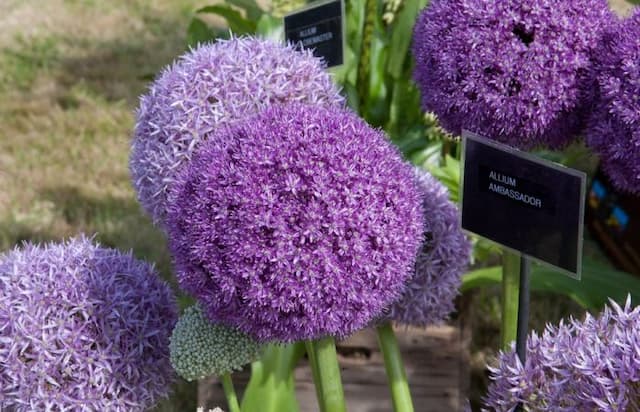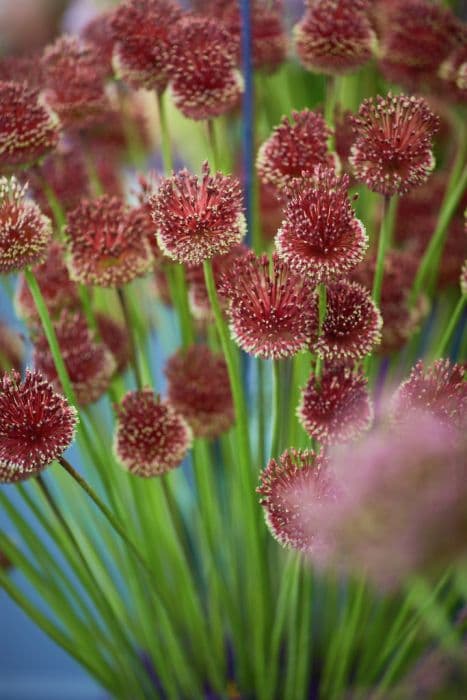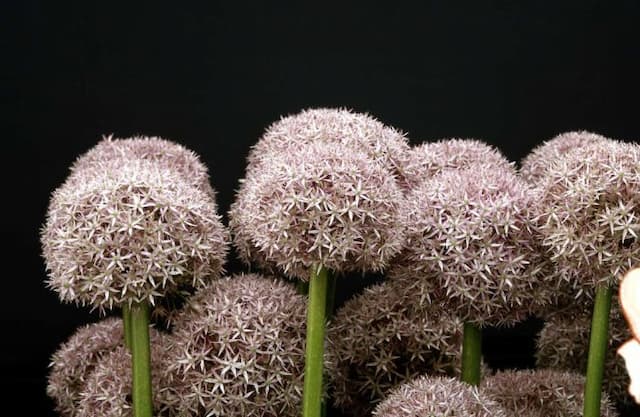Sicilian Honey Garlic Allium siculum subsp. dioscoridis











ABOUT
Allium siculum subsp. dioscoridis, commonly known as Sicilian Honey Garlic, is a bulbous perennial plant that is striking in appearance. The leaves of the Sicilian Honey Garlic are typically strap-shaped, creating an elegant foliage at the base. The flowering stems are sturdy and upright, culminating in an umbrella-like cluster of individual bell-shaped flowers. These flowers hang gracefully from the stem tip, each on its own slender stalk. The blooms of Sicilian Honey Garlic have an intricate design with a muted yet appealing color palette, often combining shades of cream, pink, and green. The petals can exhibit a subtle texture with a soft appearance, giving the flowers an ethereal quality when viewed up close. Within the flowers, the stamens may be visible, poking out slightly and presenting hints of contrasting color that catch the eye. After the flowers have been fertilized, the plant may produce seed capsules, which also hold a decorative appeal. Overall, the look of Sicilian Honey Garlic is delicate yet assertive, capable of adding both vertical interest and soft, pendulous shapes to a garden display. It is commonly planted in groups to enhance the visual impact of its distinct flowering clusters.
About this plant
 Names
NamesFamily
Amaryllidaceae
Synonyms
Sicilian Honey Garlic, Mediterranean Bells
Common names
Nectaroscordum siculum subsp. dioscoridis, Allium dioscoridis
 Toxicity
ToxicityTo humans
The plant commonly known as Sicilian honey garlic (Allium siculum subsp. dioscoridis) generally contains compounds that can be toxic to humans if ingested in large quantities. These compounds are similar to those found in other members of the Allium family such as onions and garlic, which contain thiosulfates. While Allium toxicity is more commonly reported in animals, humans with certain conditions (such as G6PD deficiency) may be susceptible to hemolytic anemia if they consume large amounts of Allium species. Symptoms can include gastrointestinal upset, such as nausea, vomiting, and diarrhea. It is important to consume this plant in moderation, as excessive consumption could lead to potential toxicity.
To pets
Sicilian honey garlic (Allium siculum subsp. dioscoridis) is toxic to pets, including cats and dogs, due to the presence of thiosulfates, which are similar to the compounds found in onions and garlic. In pets, ingestion can cause oxidative damage to red blood cells, leading to hemolytic anemia. Symptoms of Allium toxicity in pets may include vomiting, diarrhea, abdominal pain, lethargy, elevated heart rate, weakness, and in severe cases, collapse. If a pet has ingested this plant, prompt veterinary attention is advised to prevent complications such as organ damage or even death.
 Characteristics
CharacteristicsLife cycle
Perennials
Foliage type
Deciduous
Color of leaves
Green
Flower color
Pink
Height
2-3 feet (60-90 cm)
Spread
1 foot (30 cm)
Plant type
Bulb
Hardiness zones
6
Native area
Mediterranean
Benefits
 General Benefits
General Benefits- Aesthetic Appeal - Allium siculum subsp. dioscoridis, commonly known as Sicilian Honey Lily, adds visual interest to gardens with its unique bell-shaped flowers and tall, sturdy stems.
- Attracts Pollinators - The plant's blooms attract bees, butterflies, and other beneficial insects essential for the pollination of many plants and crops.
- Drought Tolerance - Once established, the Sicilian Honey Lily is fairly drought-tolerant, making it suitable for xeriscaping or gardens with low water availability.
- Deer and Rodent Resistance - The plant's inherent properties make it unappealing to deer and rodents, reducing the risk of damage from these animals.
- Perennial Growth - As a perennial, the plant will return year after year, reducing the need for replanting and maintenance.
- Easy to Grow - The Sicilian Honey Lily is not particularly demanding, making it a good choice for both novice and experienced gardeners.
- Edible Parts - Although not specifically for culinary use, some parts of the plant are edible and can be used in traditional dishes as practiced in some cultures.
- Landscape Design Versatility - The plant's striking appearance complements various garden styles, from formal to cottage gardens.
- Seasonal Interest - Its spring blooms provide early-season interest in garden landscapes.
- Cut Flower Use - The flowers of the Sicilian Honey Lily hold up well in vases, making them an attractive option for cut flower arrangements.
 Medical Properties
Medical Properties- This plant is not used for medical purposes.
 Air-purifying Qualities
Air-purifying QualitiesThis plant is not specifically known for air purifying qualities.
 Other Uses
Other Uses- Allium siculum subsp. dioscoridis, commonly known as Sicilian honey garlic, can be used for its fibers in the production of textiles or ropes, similar to other fibrous plants.
- The robust stems of Sicilian honey garlic can be dried and used in floral arrangements or as natural decor in crafts due to their unique and ornamental shape.
- The plant's flowering structure can inspire designs in jewelry, particularly earrings and pendants, reflecting its natural form.
- Sicilian honey garlic can be used in educational settings such as botany classes to study bulb development and plant physiology.
- The sequential blooming pattern of the Sicilian honey garlic can act as a living calendar or indicator of the passing seasons for gardening enthusiasts.
- This plant's potential allelopathic properties could be researched for natural weed suppression in agricultural practices.
- Dying agents can be derived from the leaves or flowers of the Sicilian honey garlic to create natural dyes for fabrics or art projects.
- In photography and painting, the unique structure of the plant may serve as a subject for exploring patterns and textures in fine art.
- The bulbs of Sicilian honey garlic can be investigated for their starch content, examining their potential use in biodegradable plastics or packaging materials.
- Cooks specializing in edible flowers may use the blossoms of the Sicilian honey garlic to add a unique visual element to haute cuisine dishes.
Interesting Facts
 Feng Shui
Feng ShuiThe Nectaroscordum is not used in Feng Shui practice.
 Zodiac Sign Compitability
Zodiac Sign CompitabilityThe Nectaroscordum is not used in astrology practice.
 Plant Symbolism
Plant Symbolism- Protection: The Allium family is commonly associated with protection, as these plants have strong scents that are believed to ward off evil spirits and bad luck.
- Strength: The robust nature and sturdy stems of the Nectaroscordum (most common common name of Allium siculum subsp. dioscoridis) suggest themes of resilience and strength.
- Unity: The clustered blooms of the Nectaroscordum, which form an umbel at the top of a tall stem, symbolize unity and togetherness, reflecting how the individual flowers come together to form a single, impressive display.
- Humility: Despite their striking appearance, Nectaroscordum does not dominate the landscape, often symbolizing modesty and humility in their unassuming yet beautiful presence.
- Good Fortune: Flowers in the Allium genus are sometimes associated with luck and prosperity, possibly derived from their round, full flower heads that mirror coins, symbolizing wealth.
 Water
WaterThe proper hydration for Sicilian Honey Garlic involves watering deeply when the topsoil feels dry, approximately once a week. During the active growing season in spring and early summer, ensure that you provide about 1-2 inches of water each week, either through rainfall or manual watering. When the plant goes dormant after flowering, reduce watering significantly to prevent bulb rot as this plant prefers drier conditions during dormancy. It is ideal to provide water in a way that avoids wetting the foliage, so using a watering can or hose attachment to direct water at the base of the plants is recommended. Over-watering should be avoided, as consistently wet soil can lead to fungal diseases or bulb rot.
 Light
LightSicilian Honey Garlic thrives best in full sun to partial shade locations. It should receive at least 6 hours of direct sunlight each day, which encourages strong growth and optimal flowering. An ideal spot would be an area where it receives morning sunlight and is protected from the harsh afternoon sun, especially in hotter climates.
 Temperature
TemperatureSicilian Honey Garlic can tolerate a range of temperatures but grows best when the weather is between 55°F and 75°F. This plant can survive winter temperatures down to roughly 20°F but should be protected from hard frosts. During the summer, if temperatures consistently exceed 80°F, the plant may go into dormancy earlier than usual.
 Pruning
PruningPruning Sicilian Honey Garlic involves removing spent flower stems after flowering to maintain a tidy appearance and prevent self-seeding if desired. However, leave the foliage in place until it dies back naturally to allow the plant to gather energy for the next season. The best time for pruning is in late spring or early summer, after the blooms have faded.
 Cleaning
CleaningAs needed
 Soil
SoilThe best soil mix for Nectar Garlic (the common name of Allium siculum subsp. dioscoridis) should be well-draining with a mix of loam and sand. Incorporating organic matter like compost will enrich the soil and promote healthy growth. The ideal soil pH for this plant is between 6.0 and 7.0.
 Repotting
RepottingNectar Garlic should be repotted every 2-3 years to refresh the soil and accommodate the growth of the bulb. It is best to repot after the flowering period when the plant is dormant.
 Humidity & Misting
Humidity & MistingNectar Garlic thrives in average outdoor humidity levels and does not require any special humidity adjustments. It is more tolerant of variations in humidity than many other plants.
 Suitable locations
Suitable locationsIndoor
Place in a sunny spot and water sparingly.
Outdoor
Plant in well-drained soil; full sun.
Hardiness zone
4-9 USDA
 Life cycle
Life cycleAllium siculum subsp. dioscoridis, commonly known as Sicilian honey garlic, begins its life cycle as a dormant bulb, which germinates under favorable conditions—typically in autumn. It develops roots and foliage during the cooler months, with leaves emerging from the ground to photosynthesize and gather energy. As temperatures rise in spring, the plant forms a tall stem and blooms with bell-shaped, pendulous flowers arranged in a loose umbel, attracting pollinators such as bees. After flowering, seeds are produced and dispersed, potentially leading to new plants if they find suitable growing conditions. Throughout the summer, the above-ground parts of the plant die back as it enters a period of dormancy, with the bulb surviving underground until the next growing season. This cycle repeats annually, with the bulb growing larger and potentially forming offsets, which can also grow into new plants.
 Propogation
PropogationPropogation time
Spring to early summer
The most popular method of propagation for Allium siculum subsp. dioscoridis, commonly known as Sicilian honey garlic, is by dividing the bulbs. This is best done in the late summer to early fall, after the leaves have died back but before the ground freezes. To divide the bulbs, carefully dig up the clump of bulbs and gently separate them by hand, making sure each division has at least one growth point. Replant the bulbs immediately at a depth of approximately 3 inches (about 7.5 centimeters) and space them about 8 inches (20 centimeters) apart to give them plenty of room to grow. Water the newly planted bulbs thoroughly to help establish them. Over time, these divisions will grow into full plants and can be divided again when they become crowded.









